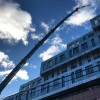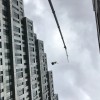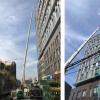Safe craning in NYC is hard work but your budget will thank you: Planning and preparation are key to a safe, efficient craning operation. The details are important- lives are at stake.
Any urban roof deck installation is an elaborate and complex undertaking, especially when the fastest, most cost-effective way to deliver soil, planters, trees and decking to the roof is by crane. Reliably delivering tons of material to a site six, twelve, twenty or more stories up can take weeks with a freight elevator- or be completed in a single day with the right piece of craning equipment. These projects typically require street closures, which mean coordinating with city agencies, obtaining permits, prepping the site, scheduling deliveries and managing teams of workers and crowds of onlookers and passersby. And all that before anything is being craned- Large scale roof deck installs are not for the inexperienced.
Choose the right company and the right equipment-
When planning a project that requires a crane of any size, it’s critical to choose an experienced, professional company. From small residential projects to very large new developments, there are many variables involved, and lives are literally at stake. Finding a knowledgeable and dependable supplier is absolutely critical.
Cranes can be a big ticket item and can prompt sticker shock even on big-budget projects. Lifting equipment can cost between $10,000 and $70,000 for a single day of craning. This is another reason to work with a qualified and experienced crane operator- they’ll help to select the right equipment for the project, avoiding the mistake of paying for equipment that is larger than necessary. There are some techniques to help squeeze the most from a budget, including sharing the cost with other contractors who need their own material brought to the roof or debris removed to street level.
Logistical ballet
Once we’ve gotten through city agency alphabet soup of DOB, DOT, landmarks and parks, and a job has received the necessary permits with approved dates, it’s critical to move swiftly to choose and contract the crane, coordinate deliveries from all your suppliers, ( a challenge deserving of it’s very own article), prepare the site and make arrangements for backup plans and equipment to manage any contingencies.
We always have a forklift on site- truckers aren’t always fond of NYC and like to unload and turn around as quickly as possible. A forklift allows pallets to be moved quickly and efficiently from wherever they’ve been unloaded to exactly where the crane operator needs them to be.
Two to three days in advance of craning, we visit the site to walk through the space and make sure everything is ready for the big day. Blondie’s Treehouse’s Vice President of Operations Ian Dana prepares a rooftop to ensure that once material is being craned, it can be staged and moved efficiently to avoid any logjams. Clearing the rooftop landing site of any material and sometimes preparing a path with high density styrofoam and plywood ensures a smooth path for our material once the crane delivers it.
While on site, we also take measurements and begin planning where the crane will be set up. This is critical- the center pin of the crane is the precise location from which all calculations must be made- 50’ out at 110’ up requires previous coordination with our suppliers to ensure deliveries are below the maximum weight for each pallet to be craned at that distance. Everything must line up perfectly with landing point. Safety always always always comes first- New York City wisely requires that when winds are over 10 mph, loads must be reduced by half. If gusts exceed 20 mph, craning is prohibited and must be rescheduled. A backup plan is absolutely essential.
We prefer all inclusive companies that handle many of these elements- we love Empire Erectors, a longtime master rigger, specializing in facilitating and overseeing craning in New York City. They provide the crane, the operator, riggers, oilman, engineer, expediter and pedestrian control. From regulations on when cranes may use bridges (before 7 am) to rerouting pedestrian traffic around a worksite, master riggers expertly navigate the regulations and challenges involved in an efficient, safe installation.
Most people aren’t aware of the hundreds of hours spent preparing and supervising the installation of a modern terrace or roof deck. Those of us who spend our days planning logistics and managing installations have a unique perspective on these relaxing spaces- And an appreciation of what’s required for everything to come together as planned.
If you’re planning a roof deck, terrace or other landscape project, we can help to answer questions you don’t even know you have- Our team of experienced Project Managers and Designers is happy to talk, anytime.







